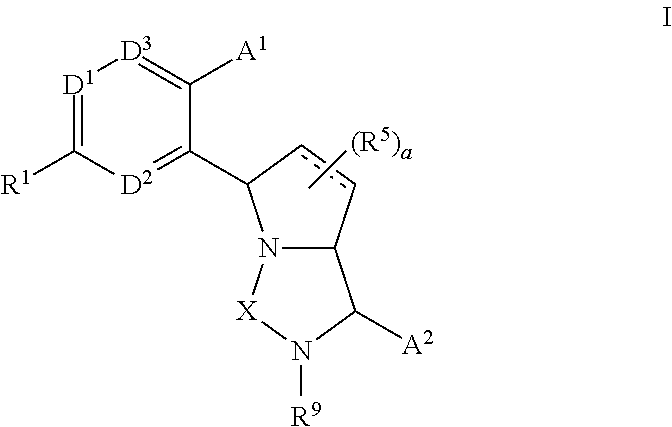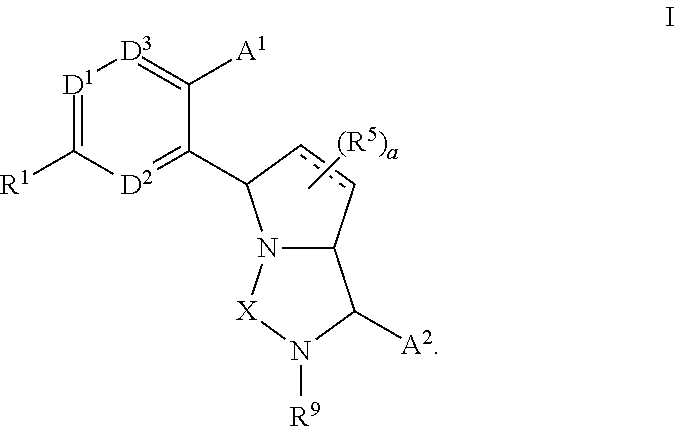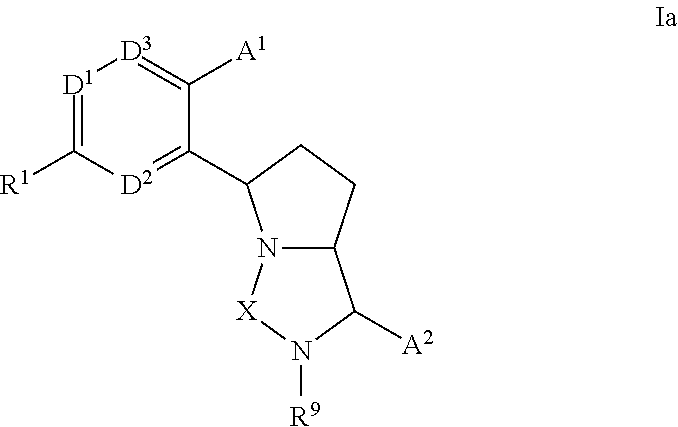Bicyclic ureas and thiadiazolidine-1, 1-dioxides as CETP inhibitors
a technology of thiadiazolidine and urea, which is applied in the field of bicyclic ureas and thiadiazolidine1, 1dioxides as cetp inhibitors, can solve the problems of statins only achieving a risk reduction of approximately one-third, and the burden of health care systems is truly enormous
- Summary
- Abstract
- Description
- Claims
- Application Information
AI Technical Summary
Benefits of technology
Problems solved by technology
Method used
Image
Examples
example 1
[0330]
4-(5-(2-((1R,5 S,7aS)-1-(3,5-bis(trifluoromethyl)phenyl)-3-oxohexahydro-1H-pyrrolo[1,2-c]imidazol-5-yl)-4-(trifluoromethyl)phenyl)-6-methoxypyridin-3-yl)-3-methylbenzoic acid
[0331]Step 1:
[0332]To a 2-5 ml microwave reaction vial was charged intermediate A1 (20 mg, 0.039 mmol) along with methyl 4-(6-methoxy-5-(4,4,5,5-tetramethyl-1,3,2-dioxaborolan-2-yl)pyridin-3-yl)-3-methylbenzoate (19.46 mg, 0.043 mmol), potassium phosphate (18.07 mg, 0.085 mmol) and chloro(2-dicyclohexylphosphino-2′,4′,6′-triisopropyl-1,1′-biphenyl)[2-(2-aminoethyl)phenyl)]palladium(II) (XPhos PreCatalyst, Aldrich, 1.430 mg, 1.935 μmol). The vial was sealed and degassed and refilled with nitrogen. Solvent THF (1 ml) and Water (0.1 ml) were then added and the vial was degassed again. The mixture was then exposed to microwave irradiation at 100° C. for 30 min. The mixture was then diluted with ethyl acetate (5 ml), filtered through a syringe filter, and was washed with ethyl acetate (2×1 mL). The filtrate was...
example 2
[0335]
4-{5-[2-{(1R,5S,7aS)-1-[3,5-bis(trifluoromethyl)phenyl]-3-oxohexahydro-1H-pyrrolo[1,2-c]imidazol-5-yl}-4-(trifluoromethyl)phenyl]-6-methoxypyridin-3-yl}-N-(1-cyanocyclopropyl)-3-methylbenzamide
[0336]Step 1:
[0337]1-Cyano-2-ethoxy-2-oxoethylidenaminooxy)dimethylamino-morpholino-carbenium hexafluorophosphate (COMU coupling reagent, 19.72 mg, 0.046 mmol) was added to a solution of 4-(5-(2-((1R,5S,7aS)-1-(3,5-bis(trifluoromethyl)phenyl)-3-oxohexahydro-1H-pyrrolo[1,2-c]imidazol-5-yl)-4-(trifluoromethyl)phenyl)-6-methoxypyridin-3-yl)-3-methylbenzoic acid (33.4 mg, 0.046 mmol), 1-aminocyclopropanecarbonitrile hydrochloride (5.47 mg, 0.046 mmol) and DIEA (0.024 ml, 0.138 mmol) in DMF (1.0 ml). The resulting mixture was stirred for 2 hrs at 40° C. The mixture was filtered through a syringe filter and purified by RP HPLC (column from YMC, 25 to 75% acetonitrile in water with 0.05% TFA) to afford a TFA salt of the product: 4-{5-[2-{(1R,5S,7aS)-1-[3,5-bis(trifluoromethyl)phenyl]-3-oxohexah...
example 3
[0338]
4-(2′-((1R,5 S,7aS)-1-(3,5-bis(trifluoromethyl)phenyl)-3-oxohexahydro-1H-pyrrolo[1,2-c]imidazol-5-yl)-6-methoxy-4′-(trifluoromethyl)-[1,1′-biphenyl]-3-yl)cyclohexanecarboxylic acid
[0339]Step 1:
[0340]To a solution of (1R,5S,7aS)-1-(3,5-bis(trifluoromethyl)phenyl)-5-(2-chloro-5-(trifluoromethyl)phenyl)tetrahydro-1H-pyrrolo[1,2-c]imidazol-3(2H)-one (50 mg, 0.097 mmol) in THF (5 mL) and water (1 mL) were added methyl 4-(4-methoxy-3-(4,4,5,5-tetramethyl-1,3,2-dioxaborolan-2-yl)phenyl)cyclohexanecarboxylate (54 mg, 0.15 mmol) and K3PO4 (45 mg, 0.21 mmol), and the reaction was deoxygenated by alternately evacuating and purging with argon for 10 min. X-phos precatalyst (4 mg, 0.005 mmol) was added and the reaction was again deoxygenated for 5 min. The reaction flask was sealed and the mixture was heated at 60° C. for 3 h. The reaction was then diluted with EtOAc, rinsed with water, dried over anhydrous Na2SO4 and concentrated. The crude product was purified by Isolera (15% EtOAc / petro...
PUM
 Login to View More
Login to View More Abstract
Description
Claims
Application Information
 Login to View More
Login to View More - R&D
- Intellectual Property
- Life Sciences
- Materials
- Tech Scout
- Unparalleled Data Quality
- Higher Quality Content
- 60% Fewer Hallucinations
Browse by: Latest US Patents, China's latest patents, Technical Efficacy Thesaurus, Application Domain, Technology Topic, Popular Technical Reports.
© 2025 PatSnap. All rights reserved.Legal|Privacy policy|Modern Slavery Act Transparency Statement|Sitemap|About US| Contact US: help@patsnap.com



